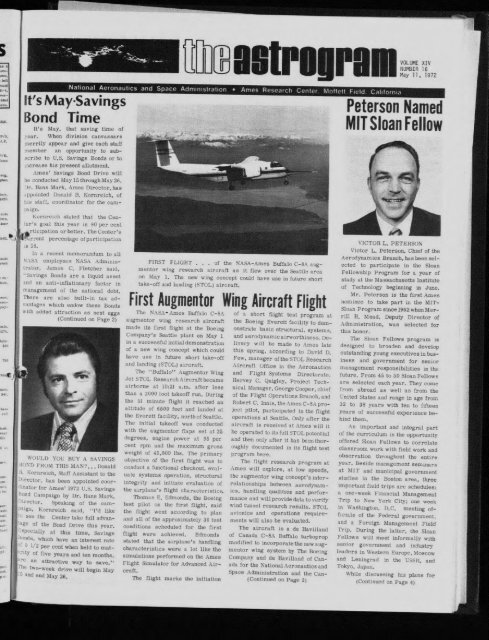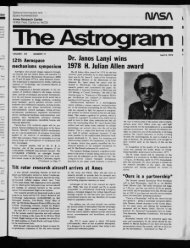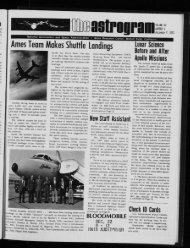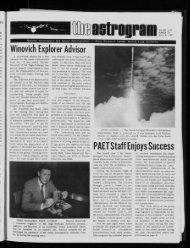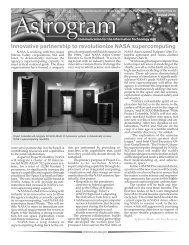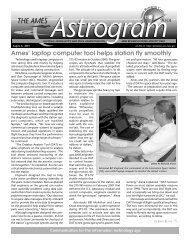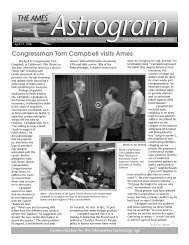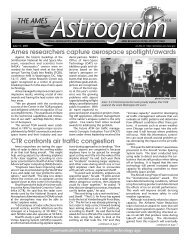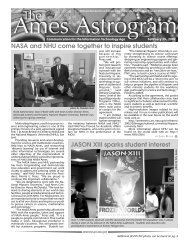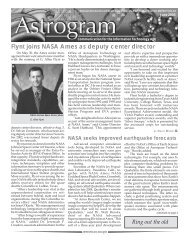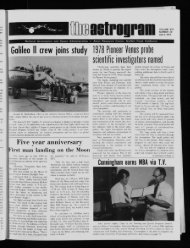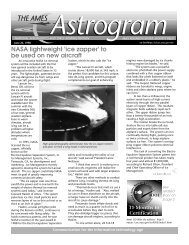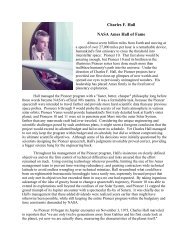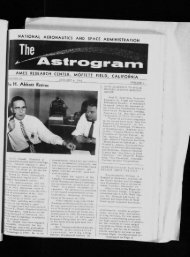First Augmentor Wing Aircraft Flight - NASA Ames History Office
First Augmentor Wing Aircraft Flight - NASA Ames History Office
First Augmentor Wing Aircraft Flight - NASA Ames History Office
Create successful ePaper yourself
Turn your PDF publications into a flip-book with our unique Google optimized e-Paper software.
National Aeronautics and Space Administrati<br />
It’s May.Savings<br />
Bond Time<br />
It’s May, that saving time of<br />
:ear. When division eanvassars<br />
merrily appear and give each staff<br />
tnember an opportunity to sub-<br />
/tribe to t’.S. Savings Bonds er to<br />
:ncrease his present allotment.<br />
<strong>Ames</strong>’ Savings Bond Drive will<br />
:L’ conducted May 15 through May 26.<br />
Jr. Hans Mark, <strong>Ames</strong> Director, has<br />
ppointed [)onuld B. Kornreich, of<br />
rlis st:Hi, coordinator tot the cam-<br />
kornreich stated that the Cencr’s<br />
goat this year Ls 8(1 per cent<br />
or better. The Center’s<br />
t~-’rcenk~g~ ot participation<br />
In , recent lrllenloralldunl to all<br />
NI>A employe~;s <strong>NASA</strong> \dminis-<br />
trltor, James C. Fletcher said,<br />
"’>avings Iionds are a liquid asset<br />
md an anti-inflationary factor ira<br />
management oI the national debt.<br />
TheFt; are also built-in tax advintages<br />
which endow these Bonds<br />
with added aEraetien as nest eggs<br />
(Continued ~m Page 2)<br />
\~,clLl,[/ "fOI. BU’~ A 5A\ING5<br />
!Nb FR.MANT...Donald<br />
;. kornre~ich, ~tait Assistani to tile<br />
I IH’t!CDU ", has b~en ;li)Poirlted coor-<br />
,nmbr for <strong>Ames</strong>’ 1972 Y.>,. Savings<br />
brad Canhrmign by Dr. Hans Mark.<br />
Spe:lkzng o! the cammien,<br />
E~u’nrciuh sdd, ’fd like<br />
i, see the Center take full advant:~gt,<br />
of the Bond Drive this )’ear.<br />
!hpeeiaHy at this time, Savings<br />
i:l!ldS, which have nit interest rate<br />
::~ 5 1/2 per cent wh~_*n held to; mat-<br />
’rity o:[ five years and ten inonths,<br />
:P*’ ~tn attractive way to save, ~<br />
]’ht) two-week drive will begin May<br />
]5 and end May 26.<br />
FIRST FLIGHT . . . of the <strong>NASA</strong>-<strong>Ames</strong> Buffalo C-8A augmeatier<br />
wing research aircraft as it fleu over the Seattle area<br />
on -’day 1. The ne,a ~*mg concept could4 have use in future short<br />
take-off and landing (STOL) aircraft.<br />
<strong>First</strong> <strong>Augmentor</strong> <strong>Wing</strong> <strong>Aircraft</strong> <strong>Flight</strong><br />
Fhc <strong>NASA</strong>-<strong>Ames</strong> Bufhdo C-8A of a short flight test program at<br />
augmenter ~ing research aircraft<br />
madt. its first flight at the Boeing<br />
Company’s Seattle plant on May 1<br />
in a ~ueeessful initial demonstration<br />
ef a new wing c,meept ~hieh could<br />
have use :n future short take-off<br />
and landing IS’Fi*L} aircraft.<br />
The "!~,uffalo’’ Augmenter V. ing<br />
Jet ,~TOI, Research<strong>Aircraft</strong> became<br />
:Hrb~,rae :it t0:21 a.m. after less<br />
than a 2000 loot t.tkeoff run. During<br />
the 51 minute flight it reached an<br />
altitude of 6500 feet and landed at<br />
the Everett facilit)’, north of Seattle.<br />
The initial takeoff was conducted<br />
with the, augmenter flaps set at 25<br />
degrees, engine po~er at 95 per<br />
cent rpm a.nd the nlaxin]unl gross<br />
weight o! 45,0(i0 lbs. ghe pmmar.~<br />
objective of the first flight was t~<br />
C/THhJLIC[ a funetiol]ai chk~ckou[, cv:ll-<br />
uate systenls operatlorl, structural<br />
and all of the al)prcximately 30 test<br />
canditions scheduled for the first<br />
flight were acbieved. Edmonds<br />
stated that the airplane’s handling<br />
characteristics were a lot like the<br />
simulatinns performed on the <strong>Ames</strong><br />
<strong>Flight</strong> Simulator for Advanced \ivcraft.<br />
The flight marks the initiation<br />
the Boeing Everett facility to demonstrate<br />
basic structural, systems,<br />
and aerodynamic airworthiness. De-<br />
liver3 will be made to Araes late<br />
this spring, according to David D.<br />
Few, manager of the STOL Research<br />
<strong>Aircraft</strong> <strong>Office</strong> in the Aeronautics<br />
and <strong>Flight</strong> Systems Directorate.<br />
Hervey C. Quigley, Project Technical<br />
Manager, George Cooper, chief<br />
of the <strong>Flight</strong> Operations Branch, and<br />
Robert C. innJs, the <strong>Ames</strong> C-hA projeer<br />
pilot, participated in the flight<br />
operations at Seattle. ,:)nly after the<br />
aircraft is received at <strong>Ames</strong> will it<br />
be operated to its furl STOL potential<br />
and then ont3 after ~.t has been thoroughiy<br />
documented in its flight test<br />
program here.<br />
Fhc flight research program at<br />
<strong>Ames</strong> will explore, at low speeds.<br />
the augme]~tor wing concept’s inter-<br />
HHegrity and initlat~ t:vaiuatit)a; of relatiousbips between aerodynam-<br />
the. airpllne’s flight ehar:tet~:r;stie~. ics, trundling qualities and perfor-<br />
Thomas E. Edmonds, the Boeing mance and willprovide data to verify<br />
test pilot ~m the first /’light, said wind tutored research results. STOL<br />
thu flight went according to plan avionics and operations require-<br />
ments will also be evaluated.<br />
The aircraft is a de Havilland<br />
of Canada C-8A Buffalo turboprop<br />
modified to incorporate the new augmentor<br />
wing system by Tim Boeing<br />
Company and de Havilland of Canada<br />
for the National Aeronautics and<br />
Spaee Administration and the Can-<br />
(Co,ntinued on Page 2)<br />
VOLUME XIV<br />
NUMBER 16<br />
May II, ~972<br />
Peterson Named<br />
MITSIoan Fellow<br />
VICTOR L. PETERSON<br />
Victor L. Peterson, Chief of the<br />
Aerodynamics Branch, has been selected<br />
to participate in the Sloan<br />
Fellowship Program for a year of<br />
study at the Massachusetts Institute<br />
of Teclmology begffmmg in June.<br />
Mr. Peterson is the first <strong>Ames</strong><br />
nominee to take part in the MIT-<br />
Siena Program since 1962 when Merrill<br />
H. Mead. Deputy Director of<br />
Administration, was selected for<br />
this honor.<br />
The Slosh Fellows program is<br />
designed to broaden and develop<br />
outstanding ymmg executives in business<br />
and government for semor<br />
management responsibilities tn the<br />
future. From 45 to 50 Sloan Fellows<br />
are selected each year. The), come<br />
from abroad as well as from the<br />
United States and range in age from<br />
32 to 38 3"ears with ten to fifteen<br />
years of successful experience behind<br />
them.<br />
\n important and integral part<br />
of the curriculum is the opportunity<br />
ofiered Siena Fellows to correlate<br />
classroom ,aork with field work and<br />
observahon throughout the entire<br />
year. Beside management seminars<br />
at ,MIT and nmnieipal government<br />
studies in the Boston area, three<br />
import.tnt field trips are schedules:<br />
a one-week Financial Management<br />
Frip to Ne~ York City; one ~eek<br />
in \Vashthgton, D.C. meeting offi~’ials<br />
of the Federal government.<br />
and a Foreign Management Field<br />
Trip. During the latter, the Sloan<br />
Fellows wi]i meet informally with<br />
senior government and industry<br />
leaders in Western Europe, Mosco’~<br />
and Leningrad in the USSI{, and<br />
Toky~h Japan.<br />
\’,’bile discussing his plans for<br />
(Continued on Page 41
Page 2 ",<br />
A Dozen Good<br />
SPARCS Launches<br />
k<br />
C-SA BUFFALO<br />
(Continued from Page 1)<br />
Astronomers have speculated about<br />
solar phenomena and how they<br />
affect the Earth for centuries. Scientists<br />
today want to know more about<br />
the rays that emanate and affect<br />
life on Earth. including radiotransmission<br />
and weather. Someday it<br />
may be possible to understand what<br />
causes solar flares, bright eruptions<br />
from the Sun’s surface which<br />
cause radio fadeouts and other disturbances.<br />
These are among the reasons for<br />
studying the sun. And, this is the<br />
value of a slim rocket called Aerobee,<br />
The <strong>NASA</strong> Aerobee is launched<br />
to over 135 miles above the Earth,<br />
where the view of the sun is relnaively<br />
clear of the obscuring atmosphere.<br />
During the firsttwominutes<br />
after launch, coarse sun sensors<br />
survey the position of the sun<br />
and roughly point the rocket’s nose<br />
in the correct direction. At the<br />
same time, jets are stopping the<br />
ballistic spin of the rocket.<br />
Also. the two-stage rocket sheds<br />
its nose cone so the fine sun sensors<br />
can finish the job of properly<br />
pointing and locking onto the sun<br />
so the instrument payload can perform<br />
its mission. The leek on the<br />
FOLLOW THE SUN . . . SPARCS, the Solar Pointing Aerobee<br />
Rocket Control System, is pictured above as it is prepared by<br />
David C. Gowan, W.V. Sterling, Inc. and Robert Fujimoto, Lockheed,<br />
for its successful April 24 launch. A large yellow and<br />
orange sun, a rendition of what the sun looks like through a hydrogen<br />
alpha filter, was painted on the solar experiment section<br />
(just below the nose cone) as part of the preparation. Heat resistant<br />
paint was used, so the art work has remained intact during<br />
both of the rocket’s round-trip missions to 135 miles above the<br />
Earth and back. The integration and assembled payload testing<br />
including nose cone and payload separations devices was conducted<br />
adian Department of Industry, Trade<br />
and Commerce (DITC).<br />
The modifications were made<br />
under contracts awarded 21 months<br />
ago, with funding of about nine million<br />
dollars by <strong>NASA</strong> and DITC.<br />
The engine nacelles and Rolls Royce<br />
Spry powerplants were delivered<br />
from Canada to The Boeing Company<br />
in Seattle. Boeing shortened<br />
the original C-SA wingspan, removed<br />
the original turboprops, built<br />
the augmentor wing system, and extensively<br />
modified the flight control<br />
The C-8A Buffalo is the first<br />
aircraft to use an augmentor wing,<br />
a concept which integrates the aircraft<br />
engine, wing and flap to increase<br />
aerodynamic lift. As part<br />
of the system, engine fan thrust<br />
is augmented and vectored by the<br />
way in which it is directed throu~lb i<br />
the augmentor flap ,and the hot thrust<br />
can he directed downward to provide<br />
increased lift.<br />
At the present stage of the research<br />
program, no significant noise<br />
reduction treatment has been incorporated<br />
in the engines used on the<br />
modified aircraft. The augmentor<br />
wing concept itself, however, has<br />
great potential for effective noise<br />
reduction.<br />
sun is maintained with hardly a<br />
quiver.<br />
The extent of this quiver isdemonstrated<br />
by the following. The nose<br />
of the Aerobee swings only four arc-<br />
at <strong>Ames</strong>.<br />
to 19 million degrees centigrade, and<br />
to obtain information on the pro-<br />
U.S.C. Course<br />
The University of Southern California<br />
offers, world-wide, a unique<br />
In its current configuration for<br />
flight research at <strong>Ames</strong>, the test<br />
airplane is designed specifically<br />
for research and is net a prototype<br />
of any proposed aircraft. " 1 I i<br />
seconds, which means it can hold in cesses that take place in the hot program of multidisciplinary stud- is not intended for commercial ser2 !<br />
view a 10-inch bullseye on a target gases present above the solar active ies leading to a master of science vice. After the current progran<br />
100 nautical miles away.<br />
All the guidance for the Solar<br />
Pointing Aerobee Rocket Control<br />
regions.<br />
Of eight solar instruments car-<br />
Ned, three obtained 100 per cent<br />
degree in Systems Management.<br />
Courses in Systems Technology,<br />
Human Factors as~aetl as Systems<br />
concludes, the a~rplane’ may be ,,j ~t<br />
gain comerted, for other STOL research.<br />
System, SPARCS, is done electron- of the data expected, four were 50 Management comprise the eurmcu- In addition to marking the first<br />
ieally without the use of gyros or per cent successful and one instrulure and are offered in the late flight of an augmenter wing air-<br />
other mechanical devices. Electronies<br />
control the amount and rate<br />
ment, an ultra violet spectrograph, afternoon at Lockheed and the Naval<br />
suffered a high voltage breakdown Air Station, Moffett Field. The sumcraft,<br />
the flight also delivered th~<br />
first "mail by Buffalo", carryinb<br />
of impulse jets emitted from ports and did not operate.<br />
mer quarter begins ,June 12. For a packet of approximately 75 letter5<br />
in the rocket to control its flight SPARCS was programmed to further details call John Levees, autographed by team members.<br />
attitude,<br />
scan across the sun at one third <strong>Ames</strong> Training <strong>Office</strong>, ext. 5623.<br />
An analog computer is used to<br />
program the maneuvers SPARCS<br />
will perform while aloft. The amount<br />
of information collected during<br />
the mission’s short trip through<br />
space is great enough to keep solar<br />
astronomers busy evaluating it for<br />
arc" minutes per second (There are<br />
60 arc minutes in a degree), roll<br />
55 degrees, and scan back across<br />
the sun. These maneuvers were<br />
carried out as planned.<br />
SPARES is designed and built by<br />
Lockheed at <strong>Ames</strong>. <strong>Ames</strong> is respon-<br />
SAVINGS BONDS<br />
(Continued from Page 1)<br />
for a more comfortable retirement<br />
or to underwrite college education<br />
NFFE Meeting<br />
The regular monthly meeting oi<br />
NFFE Local 997 is held on thethir,:<br />
Monday of the month in Building 21:i,<br />
Room 261 from 12 p.m. to 12:3~,<br />
months afterward.<br />
sible for the testing and field oper- for the youngsters.<br />
As the payload begins to fall ations of the instrumentation, pay- "in addition, Savings Bends are<br />
back to Earth parachutes open and load and nose cone separation sys- safe, pay a high 5.5 percent in-<br />
it lands gently enough to be retems and SPARCS.<br />
terest, and it is easy to particicovered,<br />
refurbished and usually Edward A. Gabris, <strong>Ames</strong>~ Vepate. All you have to do is sign<br />
reused.<br />
hicle Guidance and Control Branch, a pledge card and your payroll of-<br />
The most recent Aerobee was is Project Manager. Stanley J. Rusk fice does the rest."<br />
launched April 24 from White Sands heads the Lockheed organization. Kornreich will be assisted dur-<br />
Missile Range, New Mexico. tt was <strong>Ames</strong> Project members are: Noring the drive by Robert A. Cooper,<br />
the second flight for the rocket. man YeaRs, dames Van Ess, Morton Financial Systems and Analysis.<br />
Purpose of the flight was to map Bradski, and William Van Ark, all and Barbara F. Busch, Public Af-<br />
sun range from 1 of Vehicle and C<br />
fairs <strong>Office</strong>.<br />
se<br />
Cubs ;<br />
hating<br />
~ anla<br />
Franci<br />
in the :<br />
to be<br />
Saturd<br />
will b~<br />
No.12.<br />
The<br />
booth-<br />
Pucks,<br />
t~oSts<br />
skills<br />
terest<br />
achier<br />
fields<br />
Ash<br />
Winovi<br />
Branch<br />
his gm<br />
jeers.<br />
SOUrCel<br />
develo<br />
alga e ,<br />
beds.<br />
Scale ff<br />
the Ex[<br />
projec<br />
of is.<br />
Earl
A Pt{OUD MOMENT . . . for Darrell E. Wilcox (right), Aeronautical<br />
~lissions and Technology Branch of the Advanced Concepts<br />
and Missions Division, OAf’T, as he reads a letter of eon-<br />
gratulati~m from Dr. Hans Mark, <strong>Ames</strong> Director. This accompanied<br />
a NAS-\ Special Achievement Award presented by Richard H. Peter-<br />
sen (left). chief of the branch. Mr. Wilcox has estabtisheda noteworthy<br />
reputation in the field of program cost estimation and in<br />
the past several months has participated in four major programs.<br />
His outstanding contributions in aerospace cost estimating and<br />
co(morale studies have been recognized not only within <strong>NASA</strong> but<br />
~t the highest level ofgovernement Attesting to this were letters<br />
of appreciation incorporated in the award nomination, including<br />
one from V.’liiam Magruder..Special ConsulMnt to the President,<br />
expressing thanks ou behalf of Mr. Nixon for his efforts on a new<br />
£echnelogy Opportunities pr~qect.<br />
<strong>Ames</strong> Explorer Post Chinese<br />
In Sc0ut-O-Rama<br />
Mere than ,50,000 Boy Scouts,<br />
Cubs and Explorers are particinoting<br />
this month in 20 Scout-emma<br />
shows throughout the San<br />
Francisco Bay area..\ participant<br />
in the Stanford ~rea Council’s sho,a<br />
to be held at Foothill College on<br />
£tturday, May 20, from I2 to 6 p.m.<br />
wilI be the <strong>Ames</strong> Astremautics Pepsi<br />
No. 12.<br />
The shows are of the generll<br />
b~oth-dcmonstratkm t53~e with Cub,<br />
Packs, Scout Troops and Explorer<br />
Posts presenting a wide variety of<br />
skills, demons rations, special in-<br />
ttq’est s [Lnd V;t ri(]us itl.!n~ s in the<br />
rt chievement and advancenlent<br />
%rids.<br />
:~11" es ][)ost .’~dvi sot, Warren<br />
~.X inovieh cff the tligh-!£nthalpy<br />
Branch, said the theme selected by<br />
his group is one o! the Post prc~-<br />
Jeers. There will be :m earth resources<br />
display with instruments<br />
developed te make observations of<br />
algae growth in lakes and river<br />
beds. Also on display will be a<br />
scale model of thehmar rover which<br />
the Explorers developed as part of<br />
projects on space technology spin~<br />
offs.<br />
Earlier this month a successful<br />
Musici I<br />
The 5tanlord Area Chinese Club<br />
is presenting the musical "Damn<br />
Yankee" with a Chinese cast on<br />
Saturday evening, May 27 at 8:30<br />
p.m. in Spangenberg Auditorium,<br />
Gunn High SchooI.<br />
Fhis educational benefit for Chinese<br />
youth organiz~ticns is prodared<br />
under the sponsorship oi[ the<br />
Sm Francisco Chinatown {lptimist<br />
Club. Tickets are S3 and 84.50<br />
(unreserved) and $7.50minPmun~ for<br />
spm~.sor (reservedL For further in-<br />
lormation and tickets call Guy V, ong<br />
327-7612.<br />
5cout-(l-Ran]a was held by the Santa<br />
Clara Council at tile Santa Clara<br />
County Fairgrounds. It was interesting<br />
to note tlmt a number of<br />
young women are nowparticip~ting<br />
in I-xplorer Post activities in such<br />
:irons as veterinarian medicine and<br />
as tiara operators.<br />
Tickets for the Skmford Area<br />
Council Seout-O-Rama may be purchased<br />
from any Cub, Boy Scout<br />
or Explorer and will also be available<br />
at the gate.<br />
Page 3<br />
<strong>Ames</strong> "Classroom In The Sky"<br />
’~t’ll never be the same after<br />
this! After listening to all these<br />
brilliant men and seeing the wonderful<br />
thing it makes me proud<br />
to be as American!"<br />
"M~,’ thanks for one of the<br />
mcst ~-~pressive experiences t have<br />
~’i~d ill ~ J l(Alg time.<br />
1"hose were some of the reacticm~<br />
of the participants of "Class-<br />
:’~om in the Sky/’ ~ novel educa-<br />
tional experience cosponsored by<br />
kmes and Fresno State College.<br />
it was an extension workshop which<br />
brought 121 educators, profession-<br />
als, and students across America<br />
in a flying classroom to the launch<br />
of Apollo 16.<br />
The group not only saw the<br />
latmch, but was given a unique<br />
lesson in where Apollo 16 was going<br />
and how it would get there. While<br />
they flew from Fresno to Florida,<br />
and back again, Dr. RonaldGreeley,<br />
<strong>Ames</strong>’ Planetology Branch, conducted<br />
a course in geology.<br />
Dr. Greeley used such novel<br />
teaching aids as the Sierra Nevada<br />
Mountains, the Mississippi Delta,<br />
the Grand Canyon, the Gulf of Mex-<br />
ico and Meteorite Crater in Flagstaff,<br />
Arizona, viewed from a leisurely<br />
circling United Airlines<br />
DC~8.<br />
LulLed Airlines installed special<br />
equipment in the aircraft s,.~ that<br />
slides of lunar surface features<br />
could be shownduring Dr. Greeley’s<br />
lectures.<br />
The purpose of this segment of<br />
the course was to familiarize the<br />
participants wir2~ reasons for, and<br />
methods of studying lunar geolog3.<br />
It was r’lted by many as the most<br />
"significant" portion of the entire<br />
trip, including the launch.<br />
Dr. Greeley, who also teaches<br />
a course in geology at Foothill<br />
¯ Junior College, said of the workshop;<br />
"it helped a little to have<br />
had previous experience, but this<br />
was a unique situation. I thoroughly<br />
enjoyed it. We got to see a lot ot<br />
geology, flying over as we did. Seeing<br />
it that way really brings ,it home<br />
to the student."<br />
Another popular portion of the<br />
workshop was conducted by Richard<br />
G. Smith, Manager of Saturn Program,<br />
Marshall Spaceflight Center.<br />
He gave an "enlightening" lecture<br />
entitled "Preparing and Launching<br />
Apollo 16’s Saturn 5" foilow~ng the<br />
launch at Cape Kennedy. Many of<br />
the participants were particularly<br />
impressed with the amount of time<br />
Mr. Smith took from his obviously<br />
busy schedule to address their group<br />
and answer their questions.<br />
Dr. P. Robin Brett, Chief, Geochemistry<br />
Branch, Manned Spacecraft<br />
Center and Conrad Dannenburg,<br />
Deputy Director of Mission<br />
and Payload Planning <strong>Office</strong>, Mar-<br />
shall Spaceflight Center, also delivered<br />
enthusiastically received<br />
lectures. Dr. Brett spoke on ’.polio<br />
Lunar Science and Mr. Dannenburg<br />
discussed "Education: Springboard<br />
to Space."<br />
Garth A. Hull, <strong>Ames</strong> Educational<br />
Programs <strong>Office</strong>r and Coordinator<br />
for "Classroom in the Sky," said<br />
of the ~orkshop, "It’s of educational<br />
experience that is only possible<br />
through the teetmology we have today."<br />
"CLASSROOM IN THE SKY" . . a novel educational experience<br />
which included lectures by <strong>Ames</strong> scientists and the launch<br />
of Apollo 16. The participants are pictured above as they entered<br />
their "classroom," a modified knited Airlines DC-8.
after<br />
last issue that I dug deeper into<br />
the recesses of the Center’s past<br />
and came up with this.<br />
MORE LITTLE KNOWN FACTS<br />
ABOUT THE HISTORY OF AMES.<br />
The 16-foot windtunnelwas built<br />
in 1941 and 42, when we were the<br />
g*x~cl guys and the bad guys were the<br />
enemy. People at <strong>Ames</strong> were pretty<br />
jumpy because it looked like the<br />
enemy might bomb the West C cast<br />
as they had Pearl ttarber.<br />
This caused a few problems for<br />
the calibration of the 16-foot tunnel.<br />
You see, the tunnel’s m~tnr’s<br />
made a deep rumble, especially at<br />
night when it could be heard for<br />
miles. It kinda sounded like an approaching<br />
fleet of bombers.<br />
So, one night it had just been<br />
turned on when Mr-raid sirens began<br />
to whine and all major power<br />
absorbing equipment, including the<br />
tunnel, was ordered shut off.<br />
Happily, the enemy raid looked<br />
like a false alarm and an all-clear<br />
sounded. But no sooner had the tun-<br />
nel been turned back on than that<br />
foxy enemy came back.<br />
Again the tunnel was turned off<br />
and again they disappeared. Ah, the<br />
frustrations of wc~r!<br />
After a few more on and off<br />
air raid warnings it began to dawn<br />
on someone that there was a connection<br />
between the tunnel operation<br />
and the suspected air raid.<br />
Disillusioned, the military called<br />
off their raid for the night and<br />
arrangements were made to avoid<br />
such confusion in the future.<br />
tunity to give perspective to my<br />
previous experience here at the Center,<br />
and further insight into the principles<br />
and practice of modern management.<br />
This will help me to establish<br />
a broader viewpointof administrative<br />
functions which will be valuable<br />
both to me personally and to<br />
<strong>NASA</strong>."<br />
In his present position to which<br />
he was appointed last year, Mr.<br />
Paterson is responsible for the planning,<br />
organization, and operation of<br />
the Aerodynamms Branch, with a<br />
budget of some two million dollars<br />
and a staff of more than 35 acrespace<br />
engineers and support personuel.<br />
Mr. Paterson was graduated<br />
from Oregon State University in t956<br />
with a B.S. degree in aeronautical<br />
engineering, and earned a master<br />
of science degree in aeronautic and<br />
astronautics sciences from Stanforc~<br />
University in 1964. He began his<br />
professional career as an aero-<br />
nautical research scientist at <strong>Ames</strong><br />
in 1956.<br />
EARLY YEARS<br />
During his early years at the<br />
Center Mr. Peterson conducted<br />
numerous wind-tumml experiments<br />
and analytical investigations of both<br />
the aerodynamic characteristics of<br />
supersonic airplane configurations<br />
and the stability of aerodynamic<br />
shapes having various types of controis.<br />
"With the advent of extraterrestrial<br />
flight," he said, "I became<br />
involved in early studies of<br />
problems associated with entry into<br />
and flight within the atmospheres<br />
of planets other than earth."<br />
in 1963 Mr. Peterson was uppointed<br />
leader of the PlaneLaryGas-<br />
dynamics Group of the Hypersonic<br />
Aerodynamics Branch. In addition<br />
to directing the research of this<br />
Group, his own personal research<br />
contributed to the understanding<br />
of problems associated with entry<br />
of vehicles into planetary atmospheres<br />
and the nmtions experienced<br />
by high speed missiles.<br />
CAREER LADDER<br />
The next step up the career<br />
ladder for Mr. Paterson was the<br />
assignment as assistant chief of the<br />
Hypersonic Aerodynamics Branch.<br />
Areas researched included atmos-<br />
pheric flight mechanics, boundary<br />
layers, hypersonic aircraft aerodynamics<br />
and basic fluid dynamics.<br />
In 1969 he was selected to fill<br />
be guests on the half-hour talk show<br />
"Youth Inquires" on KRON-TV<br />
Sunday, May 21, at 12:30 p.m. Four<br />
college students will question the two<br />
<strong>Ames</strong> men on Pioneer-Jupiter and<br />
the space program in general.<br />
SOFTBALL<br />
The <strong>NASA</strong> <strong>Ames</strong> Fastpitch Softbali<br />
Team will play in the Coleman<br />
Fastpitch League at Columbus<br />
Park in San Jose. Columbus Park<br />
is located at the corner of Taylor<br />
and Spring Street<br />
The team roster includes Bruce<br />
Ganzter. manager° Bob Randte and<br />
John Yusken as eoaohes. Team<br />
ii~en~bers are Bob Bell, Gt~orge Alger,<br />
Don Kornreich, Jim Myers,<br />
Frank Steinle, Phil \% ileox, BobCof<br />
belt, Barry Scott and newcmners<br />
rein Knight, Roger Pustolka, Dan<br />
Reds and George Plambeck.<br />
FIRST HALF PLAY SCHEDULE:<br />
Date Time<br />
May 11 8:00 p.m.<br />
May 18 9:15<br />
May 25 9:15<br />
June 1 8:00<br />
June 8 6:45<br />
the post of Deputy Chief of the<br />
newly created Space Shuttle Coordination<br />
office. This office w:~s<br />
responsible for planning and coordinating,<br />
both within <strong>Ames</strong> and between<br />
~ other <strong>NASA</strong> Centers, <strong>Ames</strong><br />
entire effort supporting the National<br />
Space Shuttle Technology Program.<br />
Mr. Peterson is a member cd<br />
the American Institute of Aeronautics,<br />
and in addition to being<br />
elected as an Associate Fellow el<br />
this organization, he was chairman:<br />
of the 1500-member San Francisc<br />
Section in 1968-69, and is now ser’,mg<br />
as a member of the Atmosphere<br />
Ftight Mechanics Technical Committee,<br />
tither menlberships inclu&<br />
the American Association for Advancement<br />
of Science, Pi Mu Ep-<br />
silon, and Pi Tau Sigma, While :d<br />
<strong>Ames</strong> he has authored or eoauthor’e i<br />
35 technical publications.<br />
5loan Fellows are expected :,<br />
move to the Boston area with th,’~<br />
families so that wives and chitdrc~<br />
may benefit informally from the t~r’-<br />
found evolutions in thinking whwl:<br />
the Fellows experience during th<br />
year of intensive study. Mr. Pett, r-<br />
son will be accompanied by h><br />
wife, Jacqueline, and their thrv,<br />
children, Liuda, Janet, and Vict~’.<br />
A<br />
Be<br />
A<br />
bega]<br />
thro~<br />
dicat<br />
Driv(<br />
D<br />
sista<br />
paign<br />
about<br />
of 8<br />
Cent{<br />
patti<br />
K~<br />
not y<br />
[~,,ide<br />
Savin<br />
AI<br />
~utoii:<br />
"I)<br />
’.our<br />
i1ever<br />
*Pa<br />
Every<br />
thing<br />
a Bon<br />
ing n:<br />
builds<br />
buys t<br />
*Pa<br />
Backe,<br />
Bonds<br />
~’et ha<br />
~(’e rest<br />
eve ry
Special<br />
National Aeronautics and Space Administratio<br />
VOLUME XIV<br />
NUMBER’-I-@’17<br />
May ]8, 1972<br />
AMES 1972 U.S. SAVINGS BOND DRIVE MAY 15 to 26<br />
Bond Drive Is a Success<br />
:\rues 1972 Savings Bond Drive<br />
began Monday and will continue<br />
through May 26. Early returns indicate<br />
strong support for this year’s<br />
Drive.<br />
Donald B. Kornreich, Staff Assistant<br />
to the Director and Campaign<br />
Coordinator, is optimistic<br />
about the Center reaching it’s goal<br />
of 80 percent participation. The<br />
Center’s previous percentage of<br />
participation w~s 58.<br />
blotmreich urged those who IP, vw<br />
not yet signed up for Bonds to con-<br />
the ;tdvank~ges of a Payroll<br />
~Qt vingb l)lan.<br />
:\rnong these are2<br />
*t~c~yroll ~-avings is collv~*nlt*y~t.<br />
intse the: card is signed, saving ~s<br />
:tl]t(~!Iiat[e f~Jr It io!Ig {S yOU Iiv~.<br />
q>ayr)ll ~twngs is effi~rtloss.<br />
~our s~ving is don~ for you. You<br />
~lever nliss lllOl]Uy yol/ uev~r set’.<br />
*Payroll Savings is reguhr.<br />
Hvery payday you’re putting something<br />
aside to,ward the pur(,h:tse cd<br />
a Bond. And it’s regularity cff sating<br />
re)re thal~ anything els,: that<br />
builds up the kind c)f money that<br />
huys the big things m your future.<br />
*Pwroll Savings is sure ag>’~ safe,<br />
Backed i)y the Govermnent, Savings<br />
Bonds guarantee that you’ll alu:o,s<br />
ei back unit you put in, plus re-<br />
amara~<br />
EASY RIDER . . . Like his riding, Cal Dodson, Mechanical<br />
Services, likes to save his money the easy way through purchasing<br />
U,S. Savings Bonds. Cal said, "Savings Bonds are about the sa~est<br />
way to save. It’s become a real goodhabit of mine. It’s a convenient<br />
way of having available money all the time."<br />
=g, ome ar the Th/.gs<br />
e~Nedtodo<br />
Set, rags Bonds<br />
¢Hn<br />
rd with ~ camera the elusive.<br />
near extinct Bog Turtle<br />
A MAN MAY, IF HE KNOWS NOT<br />
HOW TO SAVE AS HE GETS. KEEP<br />
HIS NOSE TO THE GRINDSTONE.<br />
BUY U.S. SAVINGS BONDS.<br />
IF i HAVE BUT ONE PAYCHECK... Bonnie D. Malmos. Reliability<br />
and Quality Assurance, "After each successive<br />
oversea assignment with the State Department’s foreign service,<br />
l returned home with a conviction grown stronger, and to which 1<br />
continue to hold firm; that is, ’Thank God 1 am an American.’ For<br />
me, buying U.S. Savings Bonds is not only my obligation, buy my<br />
privilege and my pleasure."<br />
EVERYBODY NEEDS SAVINGS BONDS , . . Even NoeIie L.<br />
Hall (left). Thermo and Gas-Dynalnics, and Doris A. Avery (right),<br />
Simulation Sciences.<br />
BORN WITH A SAVINGS BOND IN THE BANK... Patt C,<br />
Melcie. Chemical Evolution, said she began buying Savings Bonds<br />
"for Lane’s (her 18-month-old son)education.<br />
it;<br />
MONEY ALONE SETS ALL THF .<br />
WORLD IN MOTION. BUY U.S. ’~,tl¯<br />
SAVINGS BONDS.<br />
Before I joined lhe<br />
Payroll Savings Plan<br />
all I could save<br />
string.<br />
A BIG BOND BUYER . . . O.B. flay, Mechanical Services, gas<br />
been buying Savings Bonds for over i5 years. "Buying Savings<br />
Bonds," he said of his investments, "is the only way I’ve been<br />
above ~ to save.<br />
-ii<br />
.\II<br />
nOW S<br />
istics<br />
aid of<br />
ma 8 C<br />
Val<br />
8 dr~v<br />
capabi<br />
nlan(2e<br />
from h,<br />
port. A<br />
¯ ,~imar<br />
I ;.l<br />
the Cer<br />
The<br />
the coc<br />
provid~<br />
craft ir<br />
uation.<br />
image<br />
the wit<br />
enginee<br />
reprodt<br />
ditions<br />
cemple~<br />
carrier<br />
S<br />
seiet<br />
cent(<br />
Air<br />
bear<br />
Wor~<br />
a ne<br />
Tech<br />
enabl<br />
Cent(<br />
awar,<br />
Arm]<br />
Mich~
Naliona.l Aeronautics and Space Administralion ¯ <strong>Ames</strong> Research Cenler. Moffell Field. Calilornm<br />
New Computer U.S. Savings Bond<br />
Drives <strong>Ames</strong> FSAA Drive Endsiomonaw Pi-one N-e-a<br />
SMILES AND AWARDS . . . have a way nf gong together and<br />
scientific and technical photographers William .\. Meltiar (left<br />
center) of <strong>Ames</strong>, and Charles Lonzo, Jr. (right contort of the .\rmy<br />
Air Mobility Research and Development Laboratory L’~..\MRDLI,<br />
bear this fact out as they receive Slmeial Achievement Awards.<br />
Working as a team, the two photographers set-up and operated<br />
a new precision aerial film printer in the <strong>Ames</strong> Photographic<br />
Technology Branch. The equipment is a malor acquisition and has<br />
enabled the Branch to greatly expand its support services to the<br />
Center’s earth resources sciences and aircraft programs. The<br />
awards Were presented by 11. Andrew Morse (left), Chief of the<br />
Army Aeronautical Research Group, AAMRDL, and Roland P.<br />
Michaelis (right), Chief of <strong>Ames</strong>’ Photographic ]’ethnology Branch.<br />
Pioneer 10 willenter the Asteroid<br />
Bel~ to make man’s first probe<br />
of this unexplored region on about<br />
VOLUME XIV<br />
RUMBER 18<br />
May 25, 1972<br />
Space<br />
,\rnes~ 19’72 U.S. Savings Bond Pioneer 10, bound for Jupiter. dust particles. Experimenters now<br />
Campaign will end tomorrow, May will cross the orbit of Mars today<br />
AITIeS aeronautical ~ngineersare<br />
are completing calibration of the op-<br />
26. :111 authorization cards should lMay 25) and will then enter space tics of the four asteroid telescopes,<br />
now simulating flight character- be sent to the respective division never before visited bya spacecraft.<br />
isties of advanced aircraft with the<br />
using sightings of Jupiter. These<br />
ctnvassers or to Robert A. Cooper, According to Pioneer project of-<br />
aid of a newly installed Xerox Sig-<br />
calibrations will allow measure-<br />
Mail Stop 203-12, as soon as posficials at <strong>Ames</strong>, the spacecraft wilt<br />
ma 8 computer.<br />
ments of meteoroid speed and direcsible.<br />
have crossed the 50 million miles<br />
~. alued at $1.2 milhen, the Sigma<br />
tion, using the precisely- known<br />
Mid-campaign returns indicated separating the orbits of Earth and<br />
b drives SI0 million oI equipment<br />
overlaps of the fields of view of<br />
the Center’s peruenktge of purtici- Mars in 12 weeks compared with a- the telescopes.<br />
capable of duplicating the perfof pahon will exceedprevious records. bout five months for previous Mars-<br />
:nonce of virtually any aircralt,<br />
The imaging photopolarimeter<br />
bound spacecraft.<br />
has made its first observations of<br />
from helicopter to supersonic trans-<br />
Pioneer has been in a region Mercury and Jupiter. The polariport.<br />
Although the equipment is used<br />
named by some scientists the<br />
imarily to drive tile ?~rues I;’S:XA,<br />
meter has measured the intensity<br />
pt~ rJ mentatlon.<br />
"Great Galactic Ghoul" that may and polarization of light from these<br />
serves other simulators ~t Fhe majority of research cur- containunusually high amounts ol planets, showing some characteris-<br />
the Center.<br />
rently being performed is for <strong>NASA</strong>, meteoroids and cosmic dust. Inthis tics of their atmospheres or sur-<br />
The complex simulators, under :dthough the facilities are made region, just inside the orbit of Mars,<br />
the control of the Xerox computer,<br />
faces.<br />
available to other branches of the several pervious Mars- bound Pioneer 10 will reach .Jupiter<br />
provide the realistic "feel" of the government and all aircraft com- spacecraft have encountered diffi- DecemtJer 3, 1973, and will pass<br />
craft in every conceivable flight sitpanies.culties, believed by some to be due about 87,000 miles from the giant<br />
uation, while a iull-color visual in addition to basic research to impact by high-velocity meteor-<br />
image of the flight is displayed ~n<br />
planet’s surface. It may well pass<br />
work, the Xerox Stgrna 8 will be oids.<br />
behind Jupiter’s orange satellite Io.<br />
the windows an trent of the pilot- used by the Federal Aviation .\d- The Pioneer 10 spacecraft is the the most reflective object in the<br />
engineers, These visuals no1 on]y ministr~tbm for aircraft certifi- fastest lnan-,,21ade object ever flown.<br />
reproduce grotmd and weather consolar<br />
system, allowing studies of<br />
cation studies and research on fly- Its curved flight path to Mars’ orbit<br />
,litions but also over-water flight.<br />
Io’s atmosphere if it has one.<br />
n~g quality requirements by the Na- is 136 million miles long, and it<br />
complete with a simulated drcraft tional Transpork~ion Safety Board his moved along this flight path at<br />
carrier for ktke-off and landing ex- for the invesligation of accidents. an average speed of about Ti,000<br />
miles an hour. Durmg the later parts Gein<br />
of its 22-month flight to-Jupiter next<br />
year, solar gravity will slow the 0n.<br />
spacecraft to around 25,(!00 miles<br />
an hour. It will speed up again<br />
n~ar Jupiter.<br />
Pioneer 10 has now covered 124<br />
million miles of its ~20 million-<br />
YOU’LlEN,IO"t’ rr MOBE<br />
mile flight path to Jupiter, and is<br />
IF YOU GIVE BLOOD<br />
31 million miles straight-line dis-<br />
BEFOREYOU GO. RED<br />
CROSS BLOOD PROG~.M.<br />
tat’ice froln [arth,<br />
,4.<br />
FRIDAY, JUNE 9<br />
AMES AUDITORIUM<br />
9 a.m. TILL NOON<br />
Polyglots Sought<br />
July 1. it will take about sevenmonths<br />
to cross the 175 million-mile wide<br />
Belt of rock fragments and cosmic<br />
rubble beh~een the orbits of Mars<br />
and ,Jupiter.<br />
All the spacecraft’s iI on-board<br />
scientific instruments now have been Do you speak or write a foreign<br />
turned on and are functioning welt.<br />
language? The Civil Service Com-<br />
In recent days, Pioneer flight mission in Washington, D.C. is re-<br />
directors have turned on the last of<br />
questing all goverrma,ent agencies to<br />
those, the hffrared radiometer, provide them with the names of em-<br />
which will make measurements of ployees who can fluently speak or<br />
hen t radiation in space, used to check<br />
write a foreign language. Employees<br />
out the instrument, were atexpeeted who have this skill may be asked<br />
levels.<br />
to act as interpreters or translate<br />
The meteoroid instrument and documents. Any employee having<br />
the four asteroid-meteoroid teles- these capabilities is req~sted to<br />
co~e~l~ CoRtCinue to see an unusually contact Betty Tlmmse~, R~rdea~l<br />
tamlre ir of meteoroids and Reports Branch, e×t. 5611.
Page 2<br />
LH. Brennwnld<br />
IsGued Bpenker<br />
Louis H. Brennwald, <strong>Ames</strong> Director<br />
of Administration, was guest<br />
speaker recently at a dinner meeting<br />
of the Purchasing Management<br />
Association of Northern California,<br />
lnc., held at the Cabana Hyatt House<br />
in Pale Alto.<br />
In his talk, entitled "<strong>NASA</strong> --<br />
Yesterday. Today and Tomorrow,"<br />
Mr. Brennwald gave a brief history<br />
of <strong>NASA</strong> and Center organizations,<br />
and then explained the<br />
mission and some of the long-range<br />
goals of the agency. He also discussed<br />
space technologyand its contribution<br />
to industry, as well as the<br />
application of space-related technology<br />
in solvingdomesticproblems<br />
in the public sector.<br />
<strong>Ames</strong> research scientists Richard<br />
M. Brown of the Electronic<br />
Instrulnent Development Branch<br />
also participated in the meeting. He<br />
demonstrated a laser display which<br />
showed the application of holograph}’<br />
to non-aerospace uses and holo-<br />
graphic interferometry. Mr, Brown<br />
pointed nut that the latter is being<br />
used by major tire companies and<br />
many airline to look for hidden damage<br />
in all types of tires being considered<br />
for retreading. When used<br />
for passenger car tires holographic<br />
interferometry detects possible dis-<br />
banded areas which could create a<br />
potential hazard.<br />
HTFM Institute<br />
June 14 16<br />
The twenty-third Heat Trans-<br />
fer and Fluid Mechanics Institute<br />
(HTFMI), dealing primarily with<br />
basic advances in areas of heat<br />
transfer and fluid mechanics, will<br />
be held June 14-16 at San Fernando<br />
Valley State College, Northridgc,<br />
Calif.<br />
During the three-day conference,<br />
six invited lectures and ap-<br />
proximately twenty-five papers will<br />
be presented. A special session of<br />
the conference will be devoted to<br />
heat transfer and fluid mechanics<br />
in ecological systems. Included in<br />
the participants will be Philip R.<br />
Naehtsheim of the <strong>Ames</strong> Thermal<br />
Protection Branch who will serve<br />
as co-chairman of the second session<br />
on the opening day,<br />
Registration forms may be obtained<br />
from Professor Raymond B.<br />
Landis, General Chairman of tl/e<br />
1972 HTFMI, School of Engineering<br />
at the State College in San Fernando.<br />
POWDER PUFF DERBY CONTESTANTS . . . It will be "Up,<br />
up and away" on July 7 for Sue Norman (left)and Betty Berkstressor<br />
(right), Advanced Concepts and Missions Division, who<br />
have qualified for the annual All-Woman Transcontinental Air<br />
Race (AWTAR), more familiarly known as the "Powder Puff<br />
Derby." Starting point for the race is the San Carlos Airport in<br />
California and the terminus is Tom’s River, New Jersey. The<br />
two pilots flew night and day for months prior to the entry date<br />
to qualify -- and they made it. They can use all the support they<br />
can get in planning final phase of the project. If you want to help,<br />
call Betty Berkstres~er. ext. 5887.<br />
April 14 Big Date for Two Pilots<br />
An important date in the life<br />
of pilots Mrs. Susan M. Norman<br />
and Miss Betty K. Berkstresser,<br />
Advanced Concepts and Missions<br />
Division, was April 14, I972 the day<br />
they qualified for entry in the annual<br />
All-Woman Transcontinental<br />
Air Race (Powder Puff Derby)to<br />
be held July 7. This year the race<br />
:starts from San Carlos Airport in<br />
Calif. and will end four days later<br />
at Tom’s River, New Jersey.<br />
For months prior to the entry<br />
date the two pilots flew night and<br />
day. Mrs. Norman was working toward<br />
a commercial pilot license<br />
and Miss Berkstresser wasqualify-<br />
ing for a private pilot license -both<br />
prerequisites for entry in the<br />
air race.<br />
The drawing for take-off position<br />
took place on April 28 at a dinner<br />
planned by the Golden West Chapter<br />
of the Ninety-Nines, hostess<br />
chapter for the race start. The two<br />
pilots from <strong>Ames</strong> will be TAR #75<br />
in the line-up of some 99 contestants.<br />
The first plane will take off<br />
at 9 a.m. and the rest will follow<br />
at 30-second intervals.<br />
This internationally knownPowder<br />
Puff Derby is open to all qual-<br />
ified women pilots flying eligible<br />
stock model aircraft, single or multi-engine<br />
of 145 to 450 horse power,<br />
manufactured within the last ten<br />
years. Contestants are scored according<br />
to their ground speed in<br />
relation to their handicaps. },ira.<br />
Norman and Miss Berkstresser will<br />
be flying their own Cherokee 140<br />
which has been given a handicap<br />
of I20 mph.<br />
Qualifying for entry in the race<br />
hasn’t been nearly as hard as trying<br />
to find a sponsor, according to the<br />
two women pilots. Funding from a<br />
sponsor would provide the required<br />
annual inspection, the necessary<br />
oxygen system, and the operating<br />
expenses of gas, oil, maps, food<br />
and Lodging. They expect their personal<br />
financial outlay will be in the<br />
neighborhood of $2000. Anyone interested<br />
in helping these pilots with<br />
their preparations for the forthcoming<br />
air race may call Betty Berkstresser,<br />
ext. 5887,<br />
AIAA Meeting<br />
Installation of officers for tl~e<br />
1972-73 season and a tour of the<br />
Novitiate Winery on College Avenue<br />
in Los Gates is the program for<br />
the June 1 dinner meeting of the<br />
San Francisco Section of the AIAA<br />
meeting.<br />
The winery tour will begin at<br />
5:30 p.m. with wine tasting at 6:30<br />
and dinner at 7:30. A brief ceremony<br />
honoring retiring officers and ~jl~<br />
installation of the new slate will be<br />
held at 8:30 p.m. Participants in<br />
the program will be Region VI Director<br />
Charles W. (Pat} Duffy, Jr.,<br />
and Norman Rill, Deputy Administrator<br />
for Member Services.<br />
Advance reservations are required<br />
and may be made by calling<br />
<strong>Ames</strong> ext. 5887 before May 30.<br />
Space Telescop<br />
<strong>NASA</strong> has decided to proceed<br />
with detailed planning of a large<br />
multi-purpose optical telescope to<br />
be launched and serviced by the<br />
Space Shuttle in the 1980’s.<br />
The Large Space Telescope<br />
(LST) will be able to look at galaxies<br />
100 times fainter than those<br />
seen by the most powerful groundbased<br />
optical telescope. Within the<br />
solar system, it will be able tn<br />
provide long-term monitoring o!<br />
atmospheric phenomena on Venus,<br />
Mars. Jupiter and Saturn.<br />
Scientists expect the LST to contribute<br />
significantly to the study o~<br />
energy processes that occur in halaerie<br />
nuclei; the study of early<br />
stages of stellar and solar system<br />
formation; observation of sue~<br />
highly evolved objects as superncw~<br />
remnants and white dwarfs; and<br />
other studies relevant to the ori,~,)<br />
of the universe.<br />
Project management of the LSq<br />
has been assigned by <strong>NASA</strong>’s <strong>Office</strong><br />
of Space Science to the Marshall<br />
Space <strong>Flight</strong> Center with participation<br />
in the project by the Goddarci<br />
Space <strong>Flight</strong> Center and other <strong>NASA</strong><br />
centers.<br />
The LST will weigh between 2(J.<br />
000 and 25.000 tbs. and have a lengt}:<br />
of 40 to 52 feet and a diameter of<br />
12 to 13 feet. lts most important optical<br />
element will he a diffraction-<br />
Limited mirror approximately tt-i<br />
feet in diameter.<br />
The guidance system will be capable<br />
of holding onto a target for extended<br />
periods within 0.005 seconds<br />
of r arc. (This is the angle subte~,,<br />
by a clime at a distance from Wa~ /<br />
ington to Boston.)<br />
Solar panels will provide elec-<br />
trical power to the LST, and it~<br />
images will be transmitted to Earth<br />
by television.<br />
The spacecraft will orbit Ear~<br />
at an altitude of 350 to 420 nautical<br />
miles at an inclination of 28.5 de<br />
grees.<br />
The manned Space Shuttle. whL,:5<br />
<strong>NASA</strong> is developing for operaticms<br />
beginning in the late 1970’s, will h<br />
used to launch, test and retriew<br />
the LST from orbit as required I~r<br />
repair, refurbishment, and updati~i<br />
of its instruments.<br />
havin<br />
in th<br />
Khay:<br />
is a<br />
age.<br />
lions<br />
at th<br />
tiong<br />
seg~,<br />
Fi<br />
gethe:<br />
Cess<br />
mail :<br />
tral<br />
Mana l<br />
super<br />
each z<br />
ough [<br />
syster<br />
~.3d ft<br />
~mili<br />
minol,<br />
eoyirc<br />
Anles<br />
Th,<br />
and m~<br />
gamut<br />
techni<br />
decca<br />
menis.<br />
t/i<br />
the ma<br />
fil~s a<br />
space<br />
takes i<br />
aS new<br />
are ca<br />
g~ven r<br />
T<br />
handt<br />
of cl<br />
the 1<br />
sorti
A Look At The <strong>Ames</strong><br />
Central Files Operation<br />
"The moving finger writes; and<br />
having writ, moves on . .. "Written<br />
in the eleventh century by drear<br />
Khayyam in his "Rubaiyat", this<br />
is a thought to ponder in this space<br />
age. Where do they go, those trillions<br />
of written words? A look<br />
at the <strong>Ames</strong> Central Files opera-<br />
Lion gives some insight into a small<br />
segment of those words.<br />
Five young women, working together<br />
as a closely knit team. process<br />
more than 200,000 pieces of<br />
mail received each year in the Central<br />
Files Section of the Records<br />
Management Branch. Under the able<br />
supervision of Carol A. Anderson,<br />
each member of the staff has a thorough<br />
knowledge of the mail and file<br />
system. They know the organization<br />
~bad functions of the Center and are<br />
"hmitiar with the specialized ter-<br />
minology so prevalent in a research<br />
envi ronl~ent.<br />
The central filing system at<br />
<strong>Ames</strong> involves numerous subjects<br />
and many subdivisions. They run the<br />
gamut front research reports to<br />
technical and scientific correspondence<br />
and administrative doeu-<br />
IllelltS.<br />
<strong>History</strong> is made and recorded in<br />
the material compiled in the central<br />
files as each phase of aeronautical<br />
space and life sciences research<br />
takes its place in the system. And<br />
as new "words" loin the old, the),<br />
are cataloged, cross-indexed, and<br />
given new catalog codes, if neees-<br />
As research functions, programs<br />
and operations change, the versatile<br />
central files group, Ruthie M.<br />
White, Catherine L. Garcia, Sharon<br />
M. Costa, and Margaret L. Hines,<br />
meet the challenges of revisions and<br />
new mission objectives.<br />
"Customer service" is at, integral<br />
part of the daily routine in Cen-<br />
tral Files. "Requesters seeking<br />
copies of administrative and re-<br />
search correspondence can be pretty<br />
vague in their descriptions," said<br />
Mrs. Anderson in defining some of<br />
the minor difficulties encountered by<br />
her staff. "We try to satisfy the<br />
file user as expeditiously as possible,<br />
but research subjects can tx~<br />
complicated and are hard to index<br />
and cross reference -- then the documents<br />
take time to locate."<br />
Classified document control {seeret<br />
and confidential restricted data}<br />
is another function of the Central<br />
FHe Section. Here again Mrs.<br />
Anderson could point with pride to<br />
a well-organized filing and retrieval<br />
system. "Our staff knows the<br />
security regulations," she said,<br />
"they are part of our initial training<br />
and we nit keep current in this<br />
area. There are special procedures<br />
for handling, coding and maintaining<br />
separate files and records for<br />
materials in classified categories<br />
and we follow them."<br />
Here, then. is where scrim of the<br />
words go ..... And, having writ,<br />
ntoves on . . , )J<br />
TELEPHONE REQUESTS . . . lot controlled documents are<br />
handled by Margaret tithes, shown here as she cheeks an index<br />
of classified receipts for a waiting customer. This is but one of<br />
the many functions in the classifying, eakdoging, routing and<br />
sorting of high-priority correspondence received at the Center.<br />
MAIL CALL . . . Ruthie White oI Central Files begins the<br />
review of official correspondence as it arrives at the Center and<br />
nreDares it for routing to appropriate organizations.<br />
Page 3<br />
SOLVING A PROBLEM . . takes team work as Catherine Garcia<br />
{left) and Sk~ron Coska (center) check official correspondence logs<br />
a hard-to-identify file. Carol Anderson {rightb Central Files Supervisor,<br />
is the hub el this operation where more than 200,000 prices of mail are<br />
handled each year.<br />
"AND, HAVING WRIT, MOVES ON" . . leaving behind volumes<br />
of words and document-filled filing cabinets. Here, Sharon<br />
Costa (left) reviews with Carol Anderson, Central Files super-<br />
visor, input for the chronological files which surround them.
Page 4<br />
A/r;.ys<br />
¯ . . by Jeanne Richardson<br />
Awright, no more stories about<br />
wind tunnels and phoney bombers.<br />
One person, who wishes to remain<br />
annonymous, (Hint: he’s got<br />
dart holes in his door) said that<br />
DORIS AVERY (Photo in May 18<br />
Special Issue) should be identified<br />
with Stimulation Sciences instead<br />
of Simulation. Doris, on the other<br />
hand, thinks she should be identified<br />
w}th the office of the Direc-<br />
tor of Aeronautics and <strong>Flight</strong> Systems,<br />
since that’s where she’sbeen<br />
working since February.<br />
Did you know that the Theoreiical<br />
Studies Brunch got a new secretary?<br />
They had been minus for<br />
over a year, so the arrival of<br />
DONNA HIGG1NS was a noteworthy<br />
occasion.<br />
JIM HUNTER, Machine Shop, and<br />
his wife Virginia, and their two<br />
Samoyeds drove in a caravan to<br />
the AKC meet tn Eureka recently.<br />
Then Jim and Virginia and their<br />
two Samoyeds drove home alone<br />
with their two first place ribbons.<br />
Jim said the Pebble Beach meet<br />
on May 28 will also be a howling<br />
Success.<br />
Hand-holding has been going on<br />
in the dimly-lit corners of <strong>Ames</strong>’<br />
Stewart Hill Restaurant again. The<br />
Ameorous couple was CARGL WE R-<br />
NER of the Chief Counsel’s <strong>Office</strong><br />
and GERALD ERICKSON, also (aha[)<br />
of the Chief Counsel’s <strong>Office</strong>. Deftly<br />
quelling all speculation as to the<br />
seriousness of the romance, they<br />
got married April 15 in Los Altos’<br />
St. Williams Catholic Church. Their<br />
two-week honeymoon trip included<br />
San Simeon and a visit with Carol’s<br />
family in Pennsylvania.<br />
ROGER ELY, Northrop Services<br />
Inc. with LTB, was presented with<br />
a pair of sons ?,lay 1t. His wife,<br />
Charlene, who had a lot to do with<br />
the presentation, was in Good Samaritan<br />
Hospital at the time.<br />
The boys are, Michael Alien<br />
(71bs. 1 1/2 oz.) and ttobert Erik<br />
(6 lbs. 2 oz.).<br />
DAVID CROSS, who retired from<br />
Facilities Services about a year ago,<br />
is the grandfather.<br />
Peter A. Bresler, son of Hans<br />
H. Bresler of the <strong>Ames</strong> Supply<br />
Branch, and Mrs. Bresler, will be<br />
graduated in June from the School<br />
of Medicine at the University of<br />
California, Los Angeles. The medical<br />
oath will be administered June<br />
2 and then Mr. Bresler wilt go to<br />
Montreal, Canada, where he will begin<br />
his internship at the Jewish<br />
General Hospital which is affiliated<br />
with McGill University.<br />
CHANGE OF COMMAND . . . in the Air Force Systems Cons-<br />
mand Liaison <strong>Office</strong> at <strong>Ames</strong> will take place June 1 when Lt. Col.<br />
Richard E. Kahler (left) takes over for Lt. Col. William H, Trammell<br />
(right), as Chief of the <strong>Office</strong>. Col. Trammell will be retired<br />
from the Air Force after 30 years of service at an official ceremony<br />
tc be held in the <strong>Ames</strong> Auditorium on Wednesday, May 31,<br />
at 4 p.m. <strong>Ames</strong> employees are invited to attend this ceremony.<br />
The new AFSC Liaison <strong>Office</strong>r, Col. I-:ahter, was rated as a<br />
pilot in June 1952 and has 4000 hours of flying time to his credit.<br />
He holds a master of science degree in nuclear engineering and<br />
recently completed a three-year tour of duty as Staff Safety <strong>Office</strong>r,<br />
<strong>Office</strong> of Safety and Reliability, Space Nuclear Systems Division,<br />
USAEC.<br />
Second F!ight-lst place, Russ Cravens;<br />
2nd place, Steve Hing; 3rd<br />
place, Vance ©yama; 4th place,<br />
Mitch Radovieh.<br />
Third <strong>Flight</strong>-lst place, Dick Johns,<br />
2nd place, Clark White; 3rd place,<br />
Jack Shapira; 4th place, Ruth<br />
Richardson.<br />
Fourth <strong>Flight</strong>-lst place, Elmer<br />
Hampel; 2nd place, Bill Sutton; 3rd<br />
place, Ray Forrest; 4th place, Kay<br />
Brusk.<br />
The hole-in-one prise went to<br />
Bob Carlson. The next tournament<br />
will be at Pajaro, Watsonville, and<br />
starts the 1972 <strong>Ames</strong> Matchplay<br />
Tournament.<br />
Anyone interested in go If vacation<br />
packages may contact Kay Brusk<br />
at ext. 5635, for further information.<br />
McClinto. is Treasurer<br />
GOLF<br />
of Homeowne. Group<br />
Charles H. McCliaton, Generat<br />
Accounting, was recently installed<br />
¯ . . by Kay Brusk<br />
as treasurer of the Piedmont homeowner’s<br />
association. The associa-<br />
The low-net individual score tion coordinates community affairs<br />
tournament at Spring Valley in Milpitas<br />
was played in four flights. The<br />
for the Piedmont area of San dose.<br />
co-chairmen, .John Mulkern and Ed For :~de-(Hd }io~)oinl, L%llit i~ diNhwasl’o~r, c~,bu:]~<br />
rischler, reported the follcwing<br />
3~ump and motor, r~m~ fl~, exeel[ent ~r pa~¢s or<br />
vaeaL[ol~ hQme. $20, Di~k Wrmd, 32t--~95L<br />
went home with gift certificates<br />
from the pro shop:<br />
~’0r Salu-()~le :? ~RI. :¢~d [wrJ L@ ga[tr],i Irop~ca] fish<br />
aq~riums, practkclEy n~. sold separat~ly r~r t~,-<br />
<strong>First</strong> <strong>Flight</strong>-lst place, John Mulgerber,<br />
[l:cl~ i~ c~Jl. 32~-6~’~[.<br />
kern; 2nd place, Ed Stepnoski; 3rd G~rw,oI-Shar.: ~t:cle~ b~olt-: Valley tc~ <strong>Ames</strong>, ~:3~l<br />
place. Jack Lee; 4th place, Bill<br />
Gideon.<br />
a,nl. If1 4 ~l.[i). pL¢~/Le C.~lle Wells e~I, 55a6 ,~r /]oIl;~<br />
~~40g-425-7~74.<br />
:’~r .~Me-t.larme [].F. [,Itrecti~rl [ia, ier) r~c~i~J, lune<br />
L~ac~n, hr~’ade;~st and raarine Wands. $25. 25~t-4715.<br />
For t’,ale-Tw~, t~ckets to L~. Open Champlunshi<br />
F<br />
for bat., O~ne [7 and Stmday, June IB. 1972. Aisle<br />
twa tickets Jot [@~9.1ifyJrlg r:~dnds Jtl/le 12 and 13.<br />
Call 9~8-5250.<br />
...........................<br />
For S~h~-I~r-b-que Ip~t. large graven, o~Ienta[<br />
slyle, never ~SSd, $JfJ. Call 252-1229.<br />
............................<br />
Y~r 5ale-Part c, wnershLp in Ntar-Craft r~reaUvmM<br />
"Nap-~p" ~raHer complete ~th sto~e, sink icebox,<br />
cabineLs and C]~t, sleeps sl~ ne~ conditi(gl, price<br />
~ego¢iable. phone 253-4369.<br />
F,lr Saie-Girl’a bl~, in ~k cendlti~a. $IG 961-4[B2<br />
Wa~te~-ParticlI~le in ride grip iron* LOS Gat,~s,<br />
C~ntacl l~arba~a Craven, ext. 5332.<br />
Waal~d-Paace ~md quiet. WLII trade ~e~rly ne~v extractor<br />
e~Imust system for ~1~ Jill[ ~} Nplder,<br />
for a standard exh2usl Ilys~m In g~od eo~iti~ta.<br />
Call Lope, 964-7259,<br />
For Sale-lS65 Da~umm ,S~or~ Wagon, grey, e.~aeller.I<br />
o~eralt eoz~ll ticql. 4 ~ ~Ires. 36.500 miles, 2-ow~e r.<br />
alkll~lg $~25, a~Rl~ule in Jutl~=, Fred ROSBk~L, 818-<br />
For ,c’i~le-S~a~ Royal tyFeWrl~r, gn~od rend¯ $.30.<br />
Mr, Bra~ks. 356-969fi,<br />
q<br />
WANT ADS<br />
The Astrolgr~lls’s ad ~.~tion is provid~d as a<br />
I~ersorm|, non-u’,ml~m~7~iul service to <strong>Ames</strong> e[llployees.<br />
Ad’~ortlsor i~ust I~ ici~ntlf]~d by ru~e.<br />
~:~ten~ion ~nd orl[an1~ition. TI~. ~rn~ maF br~ loll<br />
out ef th~ ad ~t Le noe.ded let l’e~ovc]s. Ads mrs[<br />
be subalitted ii* writing to The .%~rog~am, N2¢I-~,,<br />
by Thursday a week before p~bli¢~.|[on. The ~dverttser~s<br />
houl~ ~lephone ~urnLl~ m~sl be provided<br />
~g a pr~inL of cortland. ~l~pt irL ~a~pt~] r~o~iee~s,<br />
A U T(I~OB[L ES<br />
[¸.or ~Ie-1972 LJl~eL C..T., Nic~. gc)oo on g~. $6110<br />
ant} take aver pa2~’aents. ~ome. ph;~l,e 4~9-2~4~.<br />
...........................<br />
For ~ale-]962 Chevrolel pickup, 6 cyL shert ~tde<br />
bt-dr n~w engi~le, x~e~, ~ransmission. excollen~ cond~<br />
Askir.~ 5625. 243-~378.<br />
.............................<br />
[or ~qMe-~96~ CutLas.% 4-dr.. P.S.. l’.[L, 65,300<br />
relies, me~, Urea. go¢~ conc/itiur~. $SU0 I~hone<br />
967-6~5(I dter [iw’.<br />
..........................<br />
POp ~U~-l!I7[ ]J~atsun 510. I,~, do~t dM green,<br />
r & h.. ne’~ cl)rzd~tlOl~ 15ola Ptcrt~. ~2b-52(~7. $172,~.<br />
...........................<br />
[.,,)r H~Le-L965 Cnpv~ir t:om., ib~orstkck, nc~ h,I/<br />
]~o~r-trarh and brakes fine. $2~5, CalL %~Ller at<br />
...........................<br />
]ff;L:~;NG<br />
For [l~lt 3 br., 2-httth, all I~rl%tshe,! [:iGhIt’r h~lm~<br />
in pM~ :\Hu ,~,ith a ~rge f~ll% rm)n, ~]K Re!rig-<br />
~ur~ur~, 2 ear g;~rlg~% %]~ [enceti V;tyL] i~e ll,lh. 4. af~ 96[, ~d7b OF ;]![-1~5~’,<br />
..........................<br />
2 hrge b~.. srzl;tll hn~ng r l[th. ~[tLi~} rn~.. I:nui I~<br />
"2 rl~. st~d~,> ustx[ as w,~rksh,;[.-~[I}. In~er, stz/lg~<br />
p/IHK~c-~ tan ~¢. ar~a~e(l. ]red Tlu~]l~ ~4,~-IiLSI<br />
............................<br />
[ ~r ll~nl=Tah,~ Ci[) ,.oit:llg~ :~c~t" hkt- ~nd prl%-~[t:<br />
964 ~46. .........................<br />
~’er ~l~-~.larJi~sa L~x:i, fil~bt’lg hur~lll~g, g~,l~rl<br />
il~ lg. £L’rgS r,¢, 3~ar :~r.s,Jnl~ Chow~,h[]Ll ( r~3~<br />
ro:~:Js. ~.~ttr. c[e


